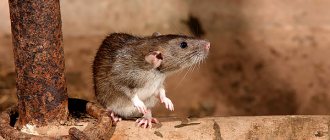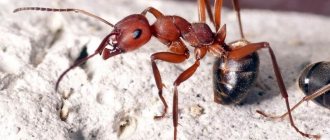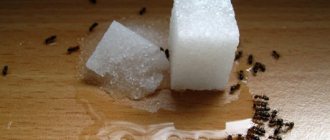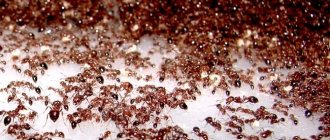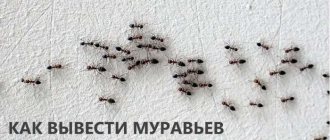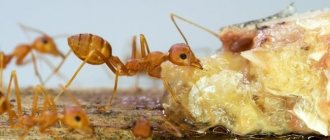Today I want to touch on a topic for gardeners and gardeners - fighting ants. Garden ants themselves (if the population is small) do not pose a danger to the vegetable garden, but there is a reason why fighting them in the garden becomes important. Insects form numerous colonies and breed aphids, which feed on the cell sap of young shoots, consuming proteins and amino acids from them necessary for growth and development, releasing sugars (carbohydrates) in the form of a sweet sticky substance called honeydew or honeydew. Flies and ants feed on these waste products of pests. That is why I want to share my experience and suggest ways to fight ants in the garden, I will tell you how to choose a remedy and teach you traditional methods of control.
Description of the insect
Ants are insects belonging to the family Formicidae. They can be found almost all over the world, some are protected, for example, the meadow ant (Formica pratensis) is listed in the Red Book, found in forests, and is a beneficial insect. Other species can cause real damage to our gardens. The following species are found in the immediate environment of humans:
- black garden ant (Lasius niger);
- yellow earthen (garden) (Lasius flavus);
- turf (Tetramorium caespitum);
- red or red myrmica (Myrmica rubra).
Chemical insecticides
The best solution to get rid of garden ants quickly and for a long time is to use insecticides. There are many such drugs; they use two active ingredients in various dosages and combinations.
- "Chlorpyrifos". It enters the body of black ants through the respiratory system. It paralyzes the nervous system, which provokes the death of the body. The substance retains its effectiveness for 30-60 days, and is retained in the soil for 110-120 days.
- "Diazinon". Blocks the production of an enzyme necessary for the normal functioning of the nervous system. This leads to convulsions, paralysis and death. The chemical is absorbed by plants and remains in them for 14-21 days. At this time they are protected from pests.
Insecticides are available in different forms: sprays, gels, liquids. They can be introduced into the soil, applied pointwise in problem areas, etc. The dosage and method of use should be found on the packaging. It is recommended to follow the instructions exactly, this guarantees safety for humans and animals.
What harm does the insect cause?
- Ants can damage young growths of ornamental plants and flower buds that contain nectar.
- Some fruits are damaged (eg apricots).
- Some species nest in the trunks or bark of trees, which negatively affects the trees and weakens them.
- They can destroy decorative flower beds, vegetable gardens and lawns when they dig underground corridors, damaging the roots, rhizomes, and tubers of plants. Corridors and tunnels additionally dry the soil.
- Insects, protecting the anthill, become very aggressive - their bites hurt, cause erythema on the skin, and sometimes allergic reactions. When insects bite, they inject a poison containing formic acid into the body.
- Ants love the sweet taste, and leftover food left on the veranda or terrace is a real treat for them. Sometimes insects move into houses and apartments in search of food.
- Ants feed on the sweet secretions of aphids, which can cause real damage to plants. They protect aphids from natural enemies (ladybugs). Some species create their own colonies of aphids - aphid larvae are transferred deep into the anthill for the winter, and in the spring adult insects are again brought outside, where they can feed on plants and supply the ants with the dew they need.
How to choose an ant repellent
The vast majority of ant preparations contain two substances: diazinon and chlorpyrifos.
Diazinon literally “hits the heart” of insects. It blocks the production of an enzyme responsible for the functioning of the nervous system of ants. They begin to have convulsions, leading to paralysis and death. In addition, it is actively absorbed by the root system of plants and protects them from pests for 2-3 weeks.
Chlorpyrifos enters the body of insects through the respiratory system and paralyzes the nervous system. The chemical is retained in the soil for 110-120 days, and it remains effective against pests for about 1-2 months.
Below we provide a brief table of the main drugs used to kill garden ants.
| Name | Active substance | Release form | Hazard Class | Consumption rate | Time to achieve effect |
| Absolute | Chlorpyrifos | Gel, plastic containers | Class IV (low-hazard drugs) | 125 ml per 30 sq.m or 2-3 containers per 10 sq.m | 10-14 days |
| Anti-ant | Borax | Powder in blisters and bags | IV | 1 container per 1-2 sq.m. | 5-6 days |
| Bros | Chlorpyrifos | Powder | IV | 10 g per 1 sq.m. | 1 day |
| Great warrior | Diazinon, chlorpyrifos | Gel | IV | 30 mg per 1 sq.m – drops onto pieces of cardboard and place next to the anthill | 1-1.5 days |
| Grom-2 | Diazinon | Granules | Class III (moderately hazardous to humans and animals) | 1-3 g per anthill | 2-4 days |
| Delicia | Chlorpyrifos | Powder | IV | 10 g per 1 sq.m. | 10-14 days |
| Medvetox | Diazinon | Granules | III class | 20 g per 10 sq.m. | 3-5 days |
| Ant-eater | Diazinon | Emulsion concentrate | III class | 1 ml/10 l of water per 5 sq.m. | 1-2 days |
| Ant | Diazinon | Granules | III class | 20 g per 10 sq.m. | 3-5 days |
| Muratox | Diazinon | Emulsion concentrate | III class | 1 ml/10 l of water per 5 sq.m. | 3 days |
| Muratsid | Diazinon | Water emulsion | III class | 1 ml/10 l of water per 5 sq.m. | 1 day |
When treating an area against ants, it is better to use eye and respiratory protection.
How are ants useful?
These insects not only cause harm, but also bring benefits:
- Thanks to them, it is easy to find colonies of aphids feeding on plants. Near the ants wandering around the plants, you can notice small, often green aphids hidden among the leaves. Aphids are a real pest, and the sooner you start fighting them, the better for the garden.
- These are our allies in the fight against pests that destroy plants in gardens - ants feed on larvae (for example, flies).
- These insects act as restorers: they feed on carrion, dead insects, small rodents or amphibians, and eat organic and plant debris, thereby cleaning their immediate environment, which we also use.
- Ants can help improve soil structure in gardens to a certain extent. When they build anthills and drill corridors into the ground, the soil is aerated.
- Insect droppings contain fertilizing elements (nitrogen, phosphorus) that improve soil quality.
Tomato tops
Tomato tops also help fight parasites. It is a good natural repellent. The effectiveness of tops lies in the fact that they contain a glycoalkaloid substance. This is a natural poison that protects nightshades from being eaten by insects.
In our case, not only fresh tops are suitable, but also dried ones. The tops are placed under the bushes of those crops that are most often affected by pests. Also, if a nest is found, the tops are laid out near it.
A more effective method of control is to prepare a decoction of the tops. To do this, prepare 4 kg of tops, which are filled with 10 liters of water. All this is infused for 4 hours. After the tincture, boil the broth for about 30-40 minutes, cool and filter. The finished solution is diluted with water in the proportion (1 part of solution and 4 parts of water). Then all places where parasites accumulate are treated.
Traditional methods
Before resorting to toxic chemicals, you should try to scare them away or find out how you can get rid of them using folk remedies and natural methods. The easiest way is to mechanically remove the pest; for this, anthills are dug up and taken away from the site. However, this will not help get rid of all pests, it will only reduce their numbers.
Corn flour
In any place where pests appear - at home or in the garden, corn flour is scattered. Insects eat flour, swell and die.
Baking powder or baking soda
This is the easiest and most affordable way to get rid of ants, because soda can be found in every home. Baking powder or quicklime baking soda is sprinkled into areas that pests visit. Soda is safe for humans and pets, so it is most often used for these purposes.
Salt and baking soda can be used to spray paths, but these substances can have adverse effects on plants (especially salt).
Boiling water
The place of accumulation and paths of insects can be poured with boiling water directly from the kettle, which will lead to significant destruction of the anthill.
Bait with honey
A saucer of honey is a great way to attract insects. Ants really like honey, they stick to it and die.
Moldy lemon
This “delicacy” eliminates pests from kitchen drawers and cabinets, which many would be afraid to treat with chemicals.
Mustard, cinnamon, tobacco
Tobacco, which can be bought at a tobacco shop or taken from cigarettes, will help in the fight against the pest. Dry mustard powder and cinnamon have a similar effect. Tobacco, cinnamon or mustard are sprinkled on places where pests accumulate, on the ground around apricot trunks and other trees and shrubs that are favored by the pest.
Boric acid
This drug is often used in the fight against household pests as an additive to bait. You can dissolve 1 spoon of boric acid in a glass of water, add a little sugar and treat the pest paths.
Water with nettles and garlic
Garlic and nettles are soaked in water for at least 2 days, then the resulting infusion is poured over the pest habitats. The insects die quickly.
Marjoram, nettle, wormwood
Some scents disturb ants, for example:
- marjoram extract;
- A lightly fermented mixture of nettle and wormwood is used to water the paths along which pests run.
Plants that repel ants
To prevent pests from leaving the garden, it is worth planting plants that these insects do not tolerate around the anthill and along their migration path. Ants do not like the following plants:
- thyme;
- garlic;
- marigold;
- marjoram;
- parsley;
- tansy;
- field mint.
Also, these insects do not like the smell of tomato leaves. You can rub the tomato leaves obtained by pinching a little in your hand before spreading them in places where unwanted guests are most frequented, so that the aroma is stronger. These pests also do not like the smell of lemon zest, walnuts, elderberries, and peppers.
Aroma oils
These insects do not like some aromatic oils:
- lavender,
- mint,
- clove
As recommendations
1. “Folk remedies” for fighting ants are simple, safe, affordable and at the same time effective ways to control the number. In addition, the cost of making traps is minimal. The only thing you need is time and patience.
2. If you cannot fight with “folk remedies,” you should not delay time and allow the number of insects to reach a critical level. Often, “folk remedies” for fighting ants do not give the desired result. Then the “heavy artillery” is used - chemical pesticides.
| READ MORE: “Insecticidal preparations for ants (summary table)” |
3. Ants cannot be eliminated completely; they are unique insects from the point of view of ethology, ecology and physiology, which have a hierarchical system of organization. Because ant colonies are highly adaptable, controlling their numbers is a matter of controlling local populations rather than eliminating entire colonies.
4. While getting carried away with the fight against ants, it is important to remember that you cannot completely destroy ants in your garden plot. Ants perform many ecological functions that are beneficial to humans, including regulating the number of insect pests (they eat butterfly caterpillars and sawfly caterpillars) and aerate the soil.
Safety precautions
When using all types of drugs or folk remedies, be sure to remember the safety rules:
- When carrying out processing, it is necessary to use protective gloves and, if necessary, a respirator.
- During work, you must not consume food or drinks.
- Baits should be placed in places protected from children and pets.
- When preparing solutions, do not use containers used for food purposes.
- All spraying and treatments are carried out only in dry, calm weather.
- Upon completion of work, hands must be thoroughly washed, clothes and shoes washed.
- You should always carefully read the labels and manufacturer's recommendations, observe the specified waiting period, during which you should refrain from contact with the treated surface. After using insecticides, it is necessary to strictly observe the deadlines for manual work.
Compliance with the rules listed above will avoid poisoning and other unwanted side effects.
Attention! Any chemicals used in the garden can affect our immediate environment. Their use must be taken into account, especially when children and animals (dogs, cats) live in the house. Chemicals also affect crops (vegetables, fruits) and other insects (for example, beneficial pollinators - bees).
Ants are one of the most common garden pests. Without timely treatment, their colonies quickly spread throughout the area, causing serious damage to various crops.
Ant
The main active ingredient of this insecticide is diazinon. The drug acts as a food bait (it looks like granules). The pellets are eaten by ants, and then the process of paralysis begins. Some of the pesticides remain on the parasites' paws, so when they get into the nest, other relatives are also infected. As a result of the Ant's action, the complete destruction of the population is possible.
Moving an anthill
Methods for getting rid of ants can be very controversial and sometimes very complicated. For example, if you find an anthill on your property, you can put it in a plastic bag, removing the entire above-ground part and the underground part - to the depth of a spade bayonet or even deeper. In the bag, the anthill is transferred to the forest away from human habitation and dumped there in a suitable place. The insects themselves will restore it. This is a fairly humane method, but labor-intensive and dangerous - the anthill can be large and heavy, and the ants bite very painfully.
The second way is, on the contrary, to bring an anthill with red ants from the forest to the site and leave it next to the home of the black ants. Two types of insects are at war. The forest ones will destroy the blacks, and they themselves will return to the forest. But the method, of course, is dubious, long and labor-intensive.
How do ants appear in the garden and garden?
In search of places with the most suitable living conditions, insects explore the surrounding area. The main thing for them is great opportunities for obtaining food and soft, cultivated soil. Their diet consists of aphids, caterpillars, butterflies, spiders, and insect corpses (a source of protein). Ants love honey, juice of berries and fruits, and seeds.
Having discovered optimal living conditions in a plot of land where there is good soil and plenty of food, they inform their relatives about their discovery using traces that they leave behind as a guide. In general, these are unpretentious creatures that can settle anywhere, but, of course, they tend to go where conditions are better.
Opportunities for building an anthill and obtaining food are not all the reasons for the appearance of these pests in vegetable gardens and orchards. It is, rather, a forced resettlement caused by the destruction of the natural habitat in the process of plowing land and construction. Ants never live alone. Having discovered individual insects on your site, there is no doubt that there is already an anthill nearby or is just being built.
Lures and traps
If there are few ants, you can destroy them by preparing traps and bait. As mentioned above, these insects love sweets. In places where ants accumulate, you can place sticky traps from which these pests will not be able to escape. Traps can be made from jam and honey, which need to be placed in bottles or jars. The ants will get inside, but will not be able to get back out. Also, sticky tape can act as a trap, which will trap aphids and ants if you wrap it around the trunks of bushes and trees. Another remedy is vegetable oil. If an ant gets into it, it will not be able to cleanse itself. Vegetable oil can be used to water paths or beds between plantings, but this method may not be the most pleasant for gardeners.
